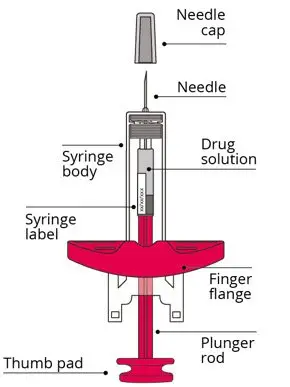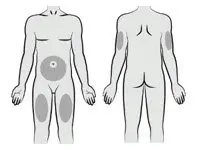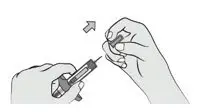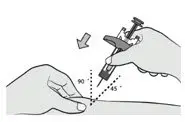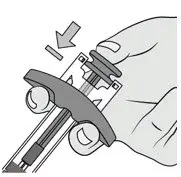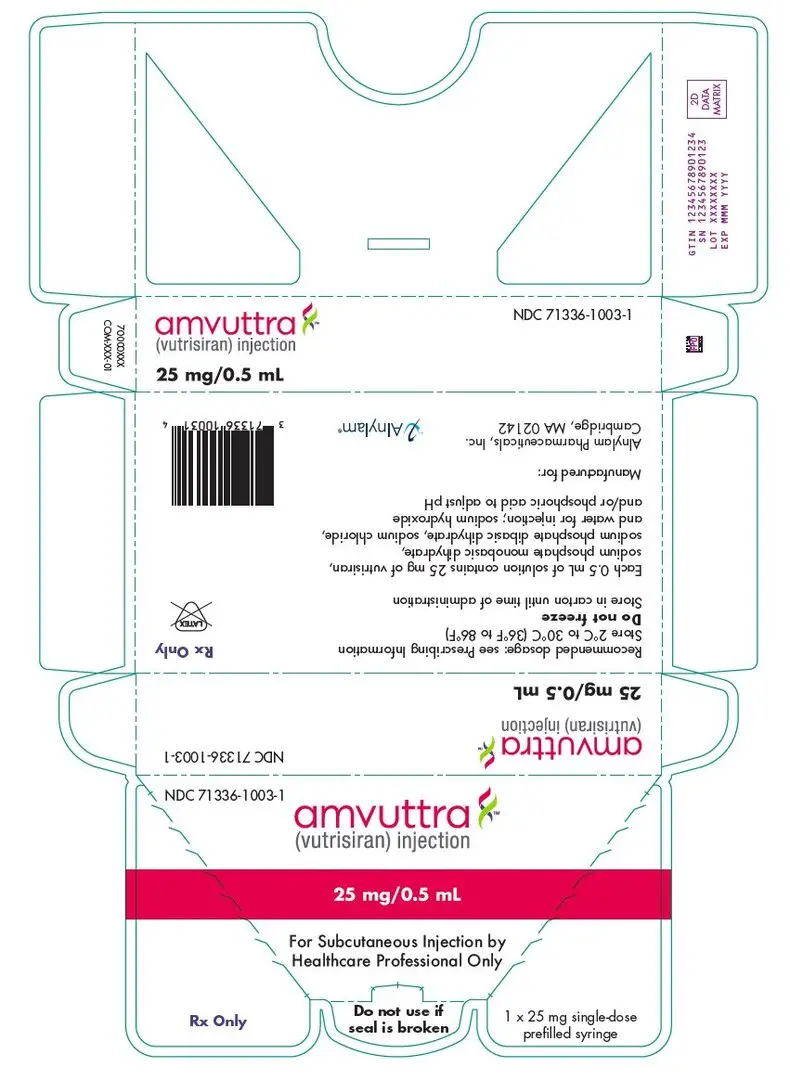Drug Detail:Amvuttra (Vutrisiran)
Drug Class: Miscellaneous metabolic agents
Highlights of Prescribing Information
AMVUTTRA (vutrisiran) injection, for subcutaneous use
Initial U.S. Approval: 2022
Indications and Usage for Amvuttra
AMVUTTRA is a transthyretin-directed small interfering RNA indicated for the treatment of the polyneuropathy of hereditary transthyretin-mediated amyloidosis in adults. (1)
Amvuttra Dosage and Administration
- The recommended dosage of AMVUTTRA is 25 mg administered by subcutaneous injection once every 3 months. (2.1)
- AMVUTTRA is for subcutaneous use only and should be administered by a healthcare professional. (2.2)
Dosage Forms and Strengths
Injection: 25 mg/0.5 mL in a single-dose prefilled syringe. (3)
Contraindications
None. (4)
Warnings and Precautions
Reduced serum vitamin A levels and recommended supplementation: Supplement with the recommended daily allowance of vitamin A. Refer to an ophthalmologist if ocular symptoms suggestive of vitamin A deficiency occur. (5.1)
Adverse Reactions/Side Effects
The most common adverse reactions (≥5%) were pain in extremity, arthralgia, dyspnea, and vitamin A decreased. (6.1)
To report SUSPECTED ADVERSE REACTIONS, contact Alnylam Pharmaceuticals at 1-877-256-9526 or FDA at 1-800-FDA-1088 or www.fda.gov/medwatch.
See 17 for PATIENT COUNSELING INFORMATION.
Revised: 2/2023
Full Prescribing Information
1. Indications and Usage for Amvuttra
AMVUTTRA is indicated for the treatment of the polyneuropathy of hereditary transthyretin-mediated amyloidosis in adults.
2. Amvuttra Dosage and Administration
2.1 Recommended Dosage
The recommended dosage of AMVUTTRA is 25 mg administered by subcutaneous injection once every 3 months [see Dosage and Administration (2.2)].
3. Dosage Forms and Strengths
Injection: 25 mg/0.5 mL of vutrisiran as a clear, colorless-to-yellow solution in a single-dose prefilled syringe.
5. Warnings and Precautions
5.1 Reduced Serum Vitamin A Levels and Recommended Supplementation
AMVUTTRA treatment leads to a decrease in serum vitamin A levels [see Adverse Reactions (6.1) and Clinical Pharmacology (12.2)].
Supplementation at the recommended daily allowance of vitamin A is advised for patients taking AMVUTTRA. Higher doses than the recommended daily allowance of vitamin A should not be given to try to achieve normal serum vitamin A levels during treatment with AMVUTTRA, as serum vitamin A levels do not reflect the total vitamin A in the body.
Patients should be referred to an ophthalmologist if they develop ocular symptoms suggestive of vitamin A deficiency (e.g., night blindness).
6. Adverse Reactions/Side Effects
The following clinically significant adverse reactions are discussed in greater detail in other sections of the labeling:
- Reduced Serum Vitamin A Levels and Recommended Supplementation [see Warnings and Precautions (5.1)]
6.1 Clinical Trials Experience
Because clinical trials are conducted under widely varying conditions, adverse reaction rates observed in the clinical trials of AMVUTTRA cannot be directly compared to rates in the clinical trials of another drug and may not reflect the rates observed in practice.
In Study 1 [see Clinical Studies (14)], a total of 122 patients with polyneuropathy caused by hereditary transthyretin-mediated amyloidosis (hATTR amyloidosis) received AMVUTTRA. Of these, 118 patients received at least 18 months of treatment. The mean duration of treatment was 18.8 months (range: 1.7 to 19.4 months). The median patient age at baseline was 60 years and 65% of the patients were male. Seventy percent of AMVUTTRA-treated patients were Caucasian, 17% were Asian, 3% were Black, and 9% were reported as Other. Forty-four percent of patients had the Val30Met mutation in the transthyretin gene; the remaining patients had one of 21 other mutations. At baseline, 70% of patients were in Stage 1 of the disease and 30% were in Stage 2.
The most common adverse reactions (at least 5%) were pain in extremity, arthralgia, dyspnea, and vitamin A decreased (see Table 1).
In Study 1, patients were instructed to take the recommended daily allowance of vitamin A [see Warnings and Precautions (5.1)]. Seventy-four percent of patients treated with AMVUTTRA had normal vitamin A levels at baseline, and 98% of those with a normal baseline developed low vitamin A levels. In some cases, the decreased vitamin A level was reported as an adverse reaction (see Table 1).
| Adverse Reaction | AMVUTTRA N=122 % |
|---|---|
|
|
| Pain in extremity* | 15 |
| Arthralgia* | 11 |
| Dyspnea* | 7 |
| Vitamin A decreased† | 7 |
Two serious adverse reactions of atrioventricular (AV) heart block (1.6%) occurred in patients treated with AMVUTTRA, including one case of complete AV block.
Injection site reactions were reported in 5 (4%) patients treated with AMVUTTRA. Reported symptoms included bruising, erythema, pain, pruritus, and warmth. Injection site reactions were mild and transient.
6.2 Immunogenicity
As with all oligonucleotides, there is potential for immunogenicity. The detection of antibody formation is highly dependent on the sensitivity and specificity of the assay. Additionally, the observed incidence of antibody (including neutralizing antibody) positivity in an assay may be influenced by several factors including assay methodology, sample handling, timing of sample collection, concomitant medications, and underlying disease. For these reasons, comparison of the incidence of antibodies in the studies described below with the incidence of antibodies in other studies or to other products may be misleading.
In Study 1, 3 (2.5%) patients treated with AMVUTTRA developed anti-drug antibodies. Although anti-drug antibody development was not found to affect the pharmacokinetics, safety, or efficacy of AMVUTTRA in these patients, the available data are too limited to make definitive conclusions.
8. Use In Specific Populations
8.5 Geriatric Use
No dose adjustment is required in patients ≥65 years of age [see Clinical Pharmacology (12.3)]. A total of 46 (38%) patients ≥65 years of age, including 7 (6%) patients ≥75 years of age, received AMVUTTRA in Study 1. No overall differences in safety or effectiveness were observed between these patients and younger patients, but greater sensitivity of some older individuals cannot be ruled out.
8.6 Renal Impairment
No dose adjustment is recommended in patients with mild or moderate renal impairment (estimated glomerular filtration rate [eGFR] ≥30 to <90 mL/min/1.73 m2) [see Clinical Pharmacology (12.3)]. AMVUTTRA has not been studied in patients with severe renal impairment or end-stage renal disease.
8.7 Hepatic Impairment
No dose adjustment is recommended in patients with mild hepatic impairment (total bilirubin ≤1 × ULN and AST >1 × ULN, or total bilirubin >1.0 to 1.5 × ULN and any AST) [see Clinical Pharmacology (12.3)]. AMVUTTRA has not been studied in patients with moderate or severe hepatic impairment.
11. Amvuttra Description
AMVUTTRA contains vutrisiran, a chemically modified double-stranded small interfering ribonucleic acid (siRNA) that targets mutant and wild-type transthyretin (TTR) messenger RNA (mRNA) and is covalently linked to a ligand containing three N-acetylgalactosamine (GalNAc) residues to enable delivery of the siRNA to hepatocytes. The structural formula of vutrisiran sodium is presented below.
 |
||
| Af, Cf, Gf, Uf = 2'-F ribonucleosides Am, Cm, Gm, Um = 2'-OMe ribonucleosides Dashed lines denote Watson-Crick base pairing | vutrisiran | |

The molecular formula of vutrisiran sodium is C530H672F9N171Na43O323P43S6 with a molecular weight of 17,290 Da. The molecular formula of the free acid is C530H715F9N171O323P43S6 with a molecular weight of 16,345 Da.
AMVUTTRA is supplied as a sterile, preservative-free, clear, colorless-to-yellow solution for subcutaneous injection. Each 0.5 mL of solution contains 25 mg of vutrisiran (equivalent to 26.5 mg vutrisiran sodium), 0.2 mg sodium phosphate monobasic dihydrate, 0.7 mg sodium phosphate dibasic dihydrate, 3.2 mg sodium chloride, water for injection, and sodium hydroxide and/or phosphoric acid to adjust the pH to ~7.
12. Amvuttra - Clinical Pharmacology
12.1 Mechanism of Action
Vutrisiran is a double-stranded siRNA-GalNAc conjugate that causes degradation of mutant and wild-type TTR mRNA through RNA interference, which results in a reduction of serum TTR protein and TTR protein deposits in tissues.
12.2 Pharmacodynamics
In Study 1 [see Clinical Studies (14)], following administration of the recommended AMVUTTRA dosage every 3 months to patients with hATTR amyloidosis, vutrisiran reduced mean serum TTR at steady state by 83%. Similar TTR reductions were observed regardless of Val30Met genotype status, weight, sex, age, or race.
Vutrisiran also reduced the mean steady state serum vitamin A by 62% over 9 months [see Warnings and Precautions (5.1)].
12.3 Pharmacokinetics
The pharmacokinetic (PK) properties of AMVUTTRA were evaluated following a single dose in healthy subjects and multiple doses in patients with hATTR amyloidosis, as summarized in Table 2.
| Vutrisiran | ||
|---|---|---|
| AUCinf = area under the concentration-time curve from the time of dosing extrapolated to infinity; AUClast = area under the concentration-time curve from the time of dosing to the last measurable concentration; Cmax = maximum plasma concentration; CV = coefficient of variation; RSE = relative standard error; Tmax = time to maximum concentration; Vd/F = apparent volume of distribution | ||
|
||
| General Information | ||
| Dose Proportionality | Vutrisiran Cmax showed dose proportional increase while AUClast and AUCinf were slightly more than dose proportional following single subcutaneous doses ranging from 5 to 300 mg (i.e., 0.2 to 12 times the recommended dose) | |
| Accumulation | No accumulation of vutrisiran was observed in plasma after repeated every 3 months dosage* | |
| Absorption | ||
| Tmax [Median (Range)] | 4 (0.17, 12.0) hours† | |
| Distribution | ||
| Estimated Vd/F (%RSE) | 10.1 (5.8) L‡ | |
| Protein Binding | 80%§ | |
| Organ Distribution | Vutrisiran distributes primarily to the liver after subcutaneous dosing | |
| Elimination | ||
| Half-Life [Median (Range)] | 5.2 (2.2, 6.4) hours† | |
| Apparent Clearance [Median (Range)] | 21.4 (19.8, 30) L/hour† | |
| Metabolism | ||
| Primary Pathway | Vutrisiran is metabolized by endo- and exonucleases to short nucleotide fragments of varying sizes within the liver | |
| Excretion | ||
| Primary Pathway | The mean fraction of unchanged vutrisiran eliminated in urine was approximately 19.4% at the recommended dose of 25 mg. The mean renal clearance of vutrisiran ranged from 4.5 to 5.7 L/hour¶ | |
14. Clinical Studies
The efficacy of AMVUTTRA was evaluated in a randomized, open-label clinical trial in adult patients with polyneuropathy caused by hATTR amyloidosis (Study 1; NCT03759379). Patients were randomized 3:1 to receive 25 mg of AMVUTTRA subcutaneously once every 3 months (N=122), or 0.3 mg/kg patisiran intravenously every 3 weeks (N=42) as a reference group. Ninety-seven percent of AMVUTTRA-treated patients and 93% of patisiran-treated patients completed at least 9 months of the assigned treatment.
Efficacy assessments were based on a comparison of the AMVUTTRA arm of Study 1 with an external placebo group in another study (NCT01960348) composed of a comparable population of adult patients with polyneuropathy caused by hATTR amyloidosis.
The primary efficacy endpoint was the change from baseline to Month 9 in modified Neuropathy Impairment Score +7 (mNIS+7). The mNIS+7 is an objective assessment of neuropathy and comprises the NIS and Modified +7 composite scores. In the version of the mNIS+7 used in the trial, the NIS objectively measures deficits in cranial nerve function, muscle strength, and reflexes, and the +7 assesses postural blood pressure, quantitative sensory testing, and peripheral nerve electrophysiology. The mNIS+7 has a total score range from 0 to 304 points, with higher scores representing a greater severity of disease.
The clinical meaningfulness of effects on the mNIS+7 was assessed by the change from baseline to Month 9 in Norfolk Quality of Life-Diabetic Neuropathy (QoL-DN) total score. The Norfolk QoL-DN scale is a patient-reported assessment that evaluates the subjective experience of neuropathy in the following domains: physical functioning/large fiber neuropathy, activities of daily living, symptoms, small fiber neuropathy, and autonomic neuropathy. The Norfolk QoL-DN has a total score range from -4 to 136, with higher scores representing greater impairment.
Additional endpoints were gait speed, as measured by the 10-meter walk test (10MWT), and modified body mass index (mBMI).
Treatment with AMVUTTRA in Study 1 resulted in statistically significant improvements in the mNIS+7, Norfolk QoL-DN total score, and 10-meter walk test at Month 9 compared to placebo in the external study (p<0.001) [Table 3, Figure 1, and Figure 3]. The distributions of changes in mNIS+7 and Norfolk QoL-DN total scores from baseline to Month 9 by percent of patients are shown in Figure 2 and Figure 4, respectively.
The change from baseline to Month 9 in modified body mass index nominally favored AMVUTTRA [Table 3].
| Endpoint† | Baseline, Mean (SD) | Change from Baseline to Month 9, LS Mean (SEM) | AMVUTTRA-Placebo* Treatment Difference, LS Mean (95% CI) | p-value | ||
|---|---|---|---|---|---|---|
| AMVUTTRA N=122 (Study 1) | Placebo*
N=77 (NCT01960348) | AMVUTTRA (Study 1) | Placebo*
(NCT01960348) |
|||
| CI = confidence interval; LS mean = least squares mean; mBMI = modified body mass index; mNIS = modified Neuropathy Impairment Score; QoL-DN = Quality of Life-Diabetic Neuropathy; SD = standard deviation; SEM = standard error of the mean | ||||||
|
||||||
| mNIS+7‡ | 60.6 (36.0) | 74.6 (37.0) | -2.2 (1.4) | 14.8 (2.0) | -17.0 (-21.8, -12.2) | p<0.001 |
| Norfolk QoL-DN‡ | 47.1 (26.3) | 55.5 (24.3) | -3.3 (1.7) | 12.9 (2.2) | -16.2 (-21.7, -10.8) | p<0.001 |
| 10-meter walk test (m/sec)§ | 1.01 (0.39) | 0.79 (0.32) | 0 (0.02) | -0.13 (0.03) | 0.13 (0.07, 0.19) | p<0.001 |
| mBMI¶ | 1058 (234) | 990 (214) | 7.6 (7.9) | -60.2 (10.1) | 67.8 (43.0, 92.6) | p<0.001 |
| A decrease in mNIS+7 indicates improvement Δ indicates between-group treatment difference, shown as the LS mean difference (95% CI) for AMVUTTRA – placebo |
|
 |
| Categories are mutually exclusive; patients who died before 9 months are summarized in the "Death" category only |
|
 |
| A decrease in Norfolk QoL-DN score indicates improvement Δ indicates between-group treatment difference, shown as the LS mean difference (95% CI) for AMVUTTRA – placebo |
|
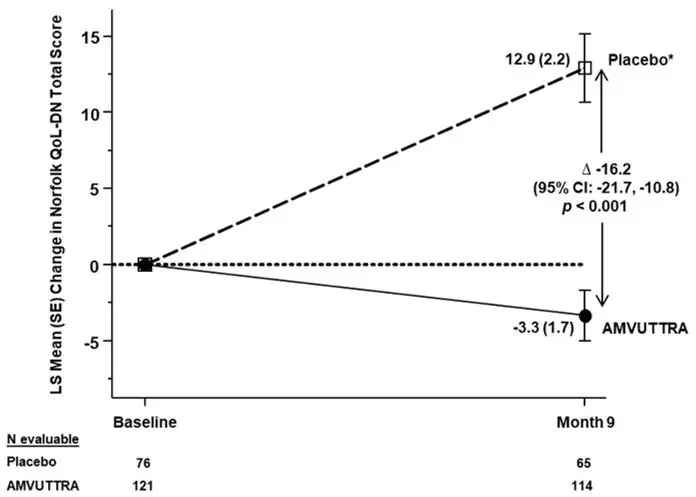 |
| Categories are mutually exclusive; patients who died before 9 months are summarized in the "Death" category only |
|
 |
Patients receiving AMVUTTRA in Study 1 experienced similar improvements relative to those in the external placebo group in mNIS+7 and Norfolk QoL-DN total score across all subgroups including age, sex, race, region, NIS score, Val30Met genotype status, and disease stage.
16. How is Amvuttra supplied
16.1 How Supplied
AMVUTTRA is a sterile, preservative-free, clear, colorless-to-yellow solution for subcutaneous injection. AMVUTTRA is supplied as 25 mg/0.5 mL solution in a single-dose 1-mL prefilled syringe made from Type I glass with stainless steel 29-gauge needle with a needle shield. The prefilled syringe components are not made with natural rubber latex.
AMVUTTRA is available in cartons containing one single-dose prefilled syringe each.
The NDC is: 71336-1003-1.
| AMVUTTRA
vutrisiran injection |
||||||||||||||||||||
|
||||||||||||||||||||
|
||||||||||||||||||||
|
||||||||||||||||||||
|
||||||||||||||||||||
|
||||||||||||||||||||
|
||||||||||||||||||||
| Labeler - Alnylam Pharmaceuticals, Inc. (115524410) |




